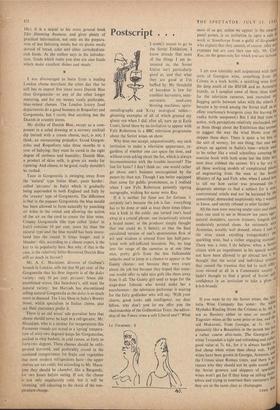Consuming Interest
Powder Room
By LESLIE ADRIAN
FORG IV E me if .someone has said it before, but our affluent society is threatening to become a flatulent society. The According to my information the slimming powders marketed at rather fancy prices consist either of protein powders (dried skimmed milk, egg white, soya bean flour, etc.) fortified with vitamins and minerals, or methyl cellulose, which has no food value, but plays the part of the dried apple rings. These powders had an antecedent in the Swedish milk diets which were placed on the 'not recommended' list by Which? nearly three years ago on the grounds that they could lead to an unbalanced, diet, and not to dietary re- education. In the same isSue of their journal the Consumers' Association accepted Formula 21 as safe, but even then three weeks' supply cost a guinea. Since Formula 21 we have had Metercal, Drama!, Complan and Quota, as the pharma- ceutical firms have tumbled to the profitability of selling these run-of-the-mill preparations as sure-fire slimming agents. But, as Miss Enid Brad- ford, writing in the current Times Review of Industry, points out, 'the same results could be obtained at far less cost by cutting out tbc starches and "bulking" the food with fruit, salads, leafy vegetables, etc., to prevent the sensation of hunger, an effect obtained by the inert methyl cellulose in these expensive pro- prietary foods.' Or you could try the dried apple rings. What you save on the powders you can spend on a copy of Professor John Yudkin's Slitnnter's Cook Book (MaeGibbon and Kee, 18s.). It is a sequel to his more general book This Slimming Business, and gives plenty of practical information, not only on the prepara- tion of less fattening meals, but on picnic meals devoid of bread, cake and other carbohydrate. rich foods. As the author says in his introduc- tion, 'foods which make you slim are also foods which make excellent dishes and meals.'
I was discouraged to learn from a leading London cheese merchant the other day that he still has to import five times more Danish Blue than Gorgonzola—or any of the other longer maturing, and for my money vastly preferable, blue-veined cheeses. The London luxury food departments do a good business in Roquefort and Gorgonzola, but I rarely find anything but the Danish in country stores.
My dislike of Danish Blue, except as a com- ponent in, a salad dressing or a savoury cocktail dip (mixed with a cream cheese, say), is not, I think, an unreasoning prejudice. Good Gorgon- zolas and Roqueforts take three months to a year of babying; they must be cured in the right degree of coolness and humidity; Danish Blue, a product of skim milk, is given six weeks for ripening. And cheese, to be good, really shouldn't be rushed.
Taste in Gorgonzola is swinging away from the 'natural' type (veins bluer, paste harder : called 'piccanie' in Italy) which is gradually being superseded in both England and Italy by the 'creamy' type of Gorgonzola. The difference is that in the piquant Gorgonzola the blue mould has been allowed to form naturally by punching air holes in the round and allowing the action of the air on the curd to create the blue veins. Creamy Gorgonzola (the type called Woke' in Italy) contains 10 per cent, more fat than the natural type and the blue mould has been inocu- lated into the round. It keeps longer, and is blander: this, according to a cheese expert, is the key to its popularity here. But why, if that is the case, is the relatively bitter-flavoured Danish Blue still so much in favour?
Mr. A. C. Macajone, director of Galbani's branch in London, tells me that 90 per cent, of the Gorgonzola that his firm imports is of the dolce variety: only 10 per cent. piccanle. Some old- established stores, like Sainsbury's, still want the natural variety : but Harrods has discontinued selling natural Gorgonzola as the do/cc is so much more in demand. The Lina Shop in Soho's Brewer Street, which specialises in Italian cheese, also say their customers prefer it.
There is an old wives' tale prevalent here that cheese should never be kept in a refrigerator; Mr.
Macajone, who is a stickler for temperatures (his Parmesan rounds are stored in a 'spring' tempera- ture of sixty-two degrees) keeps his Gorgonzolas, packed in chip baskets, in cold rooms, at forty to forty-two degrees. These cheeses should be refri- gerated (covered, and preferably stored in the insulated compartment for fruits and vegetables that most modern refrigerators have—the upper shelves are too cold); but according to Mr. Maca- jone they should be chainbre, like a Burgundy, for two hours before eating. If not, the cheese is not only unpalatably cold, but it will be `sweating,' still adjusting to the shock of the tem- perature change.



















































 Previous page
Previous page